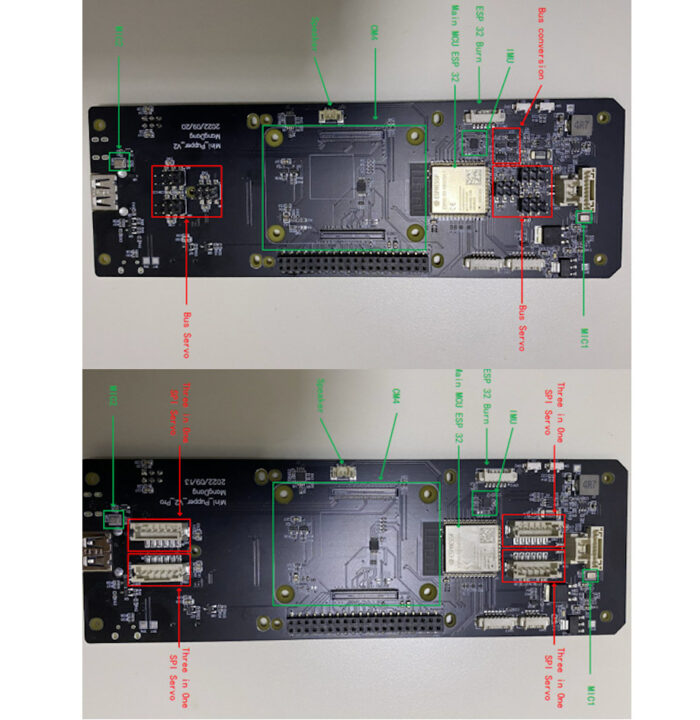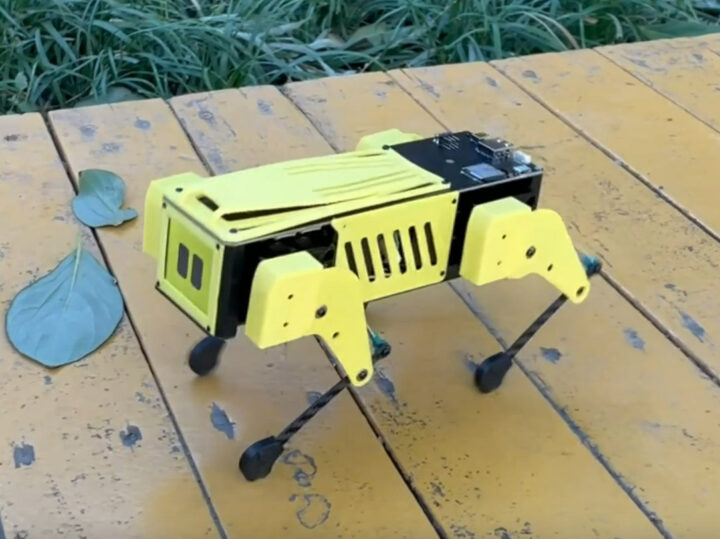Mini Pupper 2 is an improved version of the Mini Pupper robot dog powered by a Raspberry Pi 4 introduced last year. The new model support either the Raspberry Pi 4 SBC or CM4 module, adds an Arduino programmable ESP32 wireless MCU, support for ROS2, and servo feedback.
Two variants are offered with the Mini Pupper 2 implementing position servo feedback, and the Mini Pupper 2 Pro position, velocity, and torque servo feedback. Other changes common to both variants include the addition of an IMU, microphone & speaker, a touch sensor, support for autocalibration, as well as a new mobile app for control.
Mini Pupper 2 specifications:
- CPU module – Raspberry Pi 4 SBC or Raspberry Pi CM4 system on module
- MCU – ESP32 WiFi and Bluetooth dual-core microcontroller programmable with the Arduino IDE
- Display – 320×240 LCD for facial animation
- Audio – Built-in Microphone and speaker
- Camera – Support for OpenCV AI Kit Lite
- USB – Micro USB port
- 12 DOF via MangDang’s custom servos
- Servo feedback
- Mini Pupper 2 – Position
- Mini Pupper 2 Pro – Position, velocity, and torque
- Payload – Up to 200 grams
- Control algorithm – Close-loop and open-loop
- Sensor
- IMU
- Touch sensor
- Optional LiDAR module for SLAM (Simultaneous localization and mapping)
- Battery – 1,000 mAh
- Dimensions
- Raspberry CM4 model – 210 x 110 x 140 mm
- Raspberry Pi 4 model – 210 x 110 x 165 mm
- Weight – 450 grams

I understand the only difference between using a Raspberry Pi 4 or Raspberry Pi CM4 is that the latter enables a slightly thinner robot. The system runs Ubuntu 22.04 Linux OS with ROS2 or ROS1 robot operating system with the ability to control the robot with a keyboard, a web interface, or a mobile app. There’s no information about those just yet, but some tutorials can be found on the work-in-progress documentation website. The company also provides the source code for its robots on GitHub.
MangDang has launched the new Mini Pupper 2 on Kickstarter. Rewards include the $429 Mini Pupper 2 Basic Kit without Raspberry Pi and microSD card and the $529 Mini Pupper 2 Pro Basic Kit. There are also full kits that ship with a Raspberry Pi 4 or CM4, fully assembled kits, and a $299 upgrade kit for owners of the original Mini Pupper robot. Shipping adds $4.3 to $78 depending on the selected reward and destination country. Backers should expect their perks to ship in February 2023 if everything goes according to plans.

Jean-Luc started CNX Software in 2010 as a part-time endeavor, before quitting his job as a software engineering manager, and starting to write daily news, and reviews full time later in 2011.
Support CNX Software! Donate via cryptocurrencies, become a Patron on Patreon, or purchase goods on Amazon or Aliexpress





